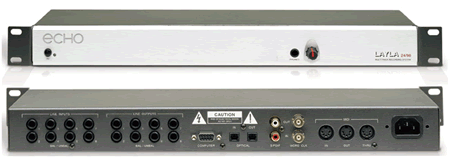
 |
Quote:
|
Quote:
|
Quote:
 |
As said it all depends on what you are comparing it too and usoing in the signals path a way to explain this is thus...
Laymans terms Using your eyes look at something familiar...a white painted wall. Now close one eye...does it look any different? (mono - stereo) Now with both eyes open look at the same wall whilst wearing a set of low end sunglasses (USB lets say) Now look at the same wall with another a better set of sunglasses (your soundcard). You are using the same set of eyes and looking at the same wall. What has changed is the sunglasses and assuming they are different then you would have noticed a variation in 'tone' of the white wall and 'scope' with one or two eyes open. Analogy explained : Your eyes = the soundsource (waveform) The wall = your speakers the end product of what you see The sunglasses = what ever components are carrying the audio signal from the source to your speakers. I really must stop visiting forums in the early morning .... |
Quote:
24-bit D-A Converter of Digital Sources: TI Burr-Brown PCM1796 *4 (123dB SNR, Max. 192kHz/24bit). 24-bit A-D Converter for Analog Inputs: Cirrus-Logic CS5381* 1 (120dB SNR, Max. 192kHz/24bit). from what i read, these are VERY good, so i dont think i will be sacrificing quality. as you can see, the support 192khz/24bit, which is the same as the virus, right? the problem is now whether the unbalanced 1/4" to 1/8" will change or distort the signal in anyway, or will it act as a regular 1/4" to 1/4" balanced input? the first one is the Digital to Analog convertor.. that would apply to the SDPIF correct? if they are both the same quality coverters, what would be the difference between using either of them |
if you have been reading good reviews about those converters then that is a good thing. The D/A and A/D converters are separate from SPDIF. If memory servers me correctly, SPDIF is a protocol for transporting data (in this case audio data) while keeping it in the digital domain. No conversion takes place from when the data stream leaves your virus to when it enters your computer for processing. On the other hand, when you use the analog outs on your virus and want to get that data into your computer, it must be converted into digital data in order for your computer to understand it. This is the Digital to Audio conversion (D/A). Once that data is in your computer and you have processed it, you will probably now want to hear it - it must therefore be converted back into the analog realm - this is the Analog to Digital conversion.
|
as far as going from 2 balanced 1/4" jacks to the 1 unbalanced 1/8" jack, I am not too sure. Perhaps someone else can chime in on that.
|
Quote:
To use the analogue outputs of the Virus in this case, you'd need a cable that has two standard 1/4" mono jacks at one end (to make up a L and R pair of channels from your Virus) and a 3.5mm stereo jack at the other end (to put into your soundcard's line-input socket). You shouldn't have too much signal degradation if cable lengths are kept relatively short. The longer the cable, the more noise it stands to pick up. Quote:
You SPDIF input will be at either 44.1KHz or 48KHz at 16-bits. The signal doesn't vary or degrade from those figures. It's locked at that quality. If you pipe audio down your SPDIF, it comes out the other end of the cable exactly the same (44.1/48KHz at 16-bits). Whereas analogue stands to degrade/change. But the SPDIF uses the same frequency and bit-depth as the USB output, so you may as well use that, unless you want to take a punt at the analogue outputs. However, as you only have 1x stereo analogue input on your soundcard, you will only be able to use a pair of outputs from the Virus's analogue outputs, and they will be unbalanced. With the USB you have 3 stereo outputs from the Virus. |
Quote:
however, my only concern is the loss of quality when using non-balanced analog cables. how much quality could i potentially lose by using this cable? since my soundcard can capture the TI at its 100%, i dont want to have to use SPDIF or USB (which both run at 48khz/16-bit max, correct?) if analog is possible. how can i get the maximum out of my Virus? |
Just want to bump this thread and continue this discussion... Im very suprised at the poll results being near 50/50 on this...
Just to clarify the poll a little better, we should be doing 3 comparisons, 1. the sound of the virus in single mode, without using virus control at all. 2. the sound of the virus in virus control mode, 1 patch loaded. 3. the same as #2 but with direct output engaged. |
| All times are GMT. The time now is 09:25 PM. |
Powered by vBulletin® Version 3.6.4
Copyright ©2000 - 2025, Jelsoft Enterprises Ltd.
Copyright ©2002-2022, Infekted.org